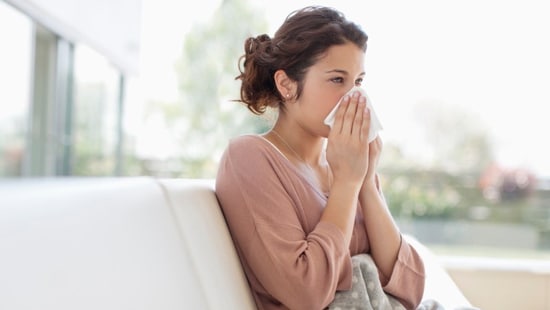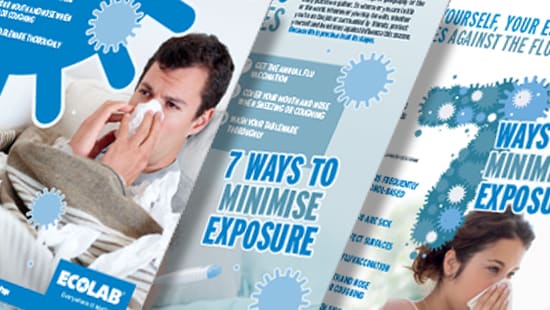Top Tips For Staying Healthy This Flu Season
Flu-fighting tips for home and work

Seasonal influenza (the flu) is a serious and contagious respiratory infection, generally transmitted from one infected person to another or from contact with surfaces contaminated with the flu virus. People who have the flu often present with fever, cough, sore throat, runny or stuffy nose, muscle or body aches, headaches and fatigue. The impact on public health and businesses due to seasonal flu can be significant.
In Europe the flu season occurs every winter and is generally from November through to April. The impact of seasonal flu can vary year to year. With flu season approaching, now is the time for families and businesses to take steps to prevent and protect against the flu.
While public health officials cannot predict the severity of the upcoming flu season, the flu sickens approximately ten to thirty per cent of Europe's population each year. Hundreds of thousands of people are hospitalized and between 15,000 – 70,000 European citizens die every year from the flu and flu-related complications. Older people, younger children and those with chronic conditions suffer the most, but everyone is at risk. The wide range of deaths related to influenza infection is due to the severity of each flu season.
Flu has a significant impact on businesses as well. The potential for staff shortages, productivity and production losses as well as pressure and costs on the health and social care services are significant. Fortunately, there are a number of important measures that businesses and families can take to reduce the risk of flu. Here are our top tips to help reduce the risk of spreading the seasonal flu:
- Wash your hands frequently
Proper hand hygiene / hand-washing is essential to preventing influenza contamination. Proper hand-washing helps remove bacteria, viruses and other pathogens, so they can’t be spread to others. The ECDC recommends the following:
- Hands should be washed thoroughly with soap and water.
- After washing with soap and water, dry hands thoroughly with single-use paper towels. Hand-washing with drying of hands should last for at least 40-60 seconds each time.
- Alcohol-based hand sanitizers reduce the amount of influenza virus on contaminated hands. When hand-washing is not possible, alcohol-based hand sanitizers are an option.
- Avoid other that are sick & stay home yourself when sick
For the flu to be transmitted the virus must travel from an individual who has contracted the flu virus to another person, who can then become infected. Individuals who have contracted the flu virus are contagious at least one day prior to displaying symptoms, and up to seven days after they first appear. You can reduce the risk of transmission through social distancing by avoiding others who are sick and staying home yourself if sick.
- Clean & disinfectant surfaces
The flu virus can survive up to 48 hours on stainless steel and plastic surfaces, and up to 12 hours on cloth, paper and tissues. Proper cleaning and disinfecting can minimise the chances of individuals contracting the virus from a contaminated surface. To properly clean, disinfect and protect your environment:
- Clean any visible soil from surfaces before disinfecting. When cleaning and disinfecting, work from top to bottom and from cleaner to more heavily soiled surfaces.
- Thoroughly wet the surface with a BPD-registered disinfectant with claims for Influenza A and follow label instructions.
- Disinfect frequently touched hard surfaces often, including tables, chairs, light switches, door handles and restroom facilities.
- Give special attention to frequently touched surfaces in food preparation areas, as well as the restroom, including light switches, faucets, toilet flush levers, door knobs and handrails.
- Get the flu vaccination
Getting a flu vaccine and taking antiviral medications as prescribed by healthcare providers, are two ways the European Centres for Disease Control and Prevention (ECDC) advocates stopping the spread of flu germs. The flu vaccine is one of the most effective forms of protection against seasonal flu.
- Cover your mouth and nose when sneezing
Coughing and sneezing into your elbow or a tissue helps protect others. If you do have seasonal flu and do not cover your nose or mouth a person or persons with two meters can be infected.
- Wash your tableware thoroughly
Eating utensils, dishes and glasses should all be thoroughly washed either in a dishwasher or by hand with water and dishwashing detergent.
To download our latest flu materials and additional information on how Ecolab can help you and your business prepare for the flu season ahead and minimise exposure visit our webpage.
Sources:
ECDC. Factsheet about seasonal influenza. Retrieved from https://ecdc.europa.eu/en/seasonal-influenza/facts/factsheet
ECDC. Personal protective measures (non-pharmaceutical) for reducing the risk of acquiring or transmitting human influenza. Retrieved from https://ecdc.europa.eu/en/seasonal-influenza/prevention-and-control/personal-protective-measures
CDC. How To Clean and Disinfect Schools To Help Slow the Spread of Flu. Retrieved from https://www.cdc.gov/flu/school/cleaning.htm
CDC. Preventative steps. Retrieved from https://www.cdc.gov/flu/consumer/prevention.htm
Related Articles

Flu resources
Click here to download our latest flu materials and additional information on how Ecolab can help you and your business prepare for the flu season ahead and minimise exposure.


